You’re sitting at home, holding that adorable little bundle of joy, and so glad the hard part is over. Then you look down at that big squishy blob that used to be your stomach and wonder, “What in the hell am I going to do about that?!”
Let me tell you, this is where the hard work really begins, sister. Even if you lifted all throughout your pregnancy, those muscles that used to be your abs are shot. They have been stretched and abused beyond recognition.
You’re sitting at home, holding that adorable little bundle of joy, and so glad the hard part is over. Then you look down at that big squishy blob that used to be your stomach and wonder, “What in the hell am I going to do about that?!”
Let me tell you, this is where the hard work really begins, sister. Even if you lifted all throughout your pregnancy, those muscles that used to be your abs are shot. They have been stretched and abused beyond recognition.
The first sign of complete lack of core strength comes when your back starts to ache after holding your little eight pounds worth of baby for just a few minutes. Because your abdominal muscles are giving you no support, your back is working overtime trying to keep your torso upright. Not to mention, you’ve got that extra what-seems-like fifty pounds of milk-engorged boob pulling you forward.
How Pregnancy Affects the Core
When you think of the core, chances are you think of the abs. However, the core actually consists of all the muscles that encompass your midsection, including your back and hips. As you have probably already experienced, pregnancy wreaks havoc on these areas. Between the stretched and weakened abdominal muscles, the shortened and overworked back muscles, and the slightly unstable hips that seem to have gotten a bit wider, there’s a good chance you’ll find that your old ten-rep-max now feels like a personal record attempt.
This doesn’t necessarily mean your strength is gone, but rather that the all-important ability to create the intra-abdominal pressure necessary to stiffen and keep your torso erect is no longer possible. As a result, you’re folding over faster than a dollar bill in a stripper’s G-string. Now is the time to get back to basics and work on rebuilding your core before you get busy trying to hit those heavy lifts.
Diastasis Recti
First, you need to assess yourself for diastasis recti. This occurs when the connective tissue between your abdominal muscles thins, causing your muscles to separate. This is a common pregnancy condition, but some women may have a more severe case.
To check for diastasis recti, simply lie on your back, contract your abdominal muscles and press gently into your abdomen above and below your navel. If you can feel a soft spot or gap between the muscles, then you do have a separation. One to two finger-widths is normal and should close on its own. If your gap is wider than three finger-widths, it may not be a bad idea to contact a physical therapist to ensure proper closing of the gap.
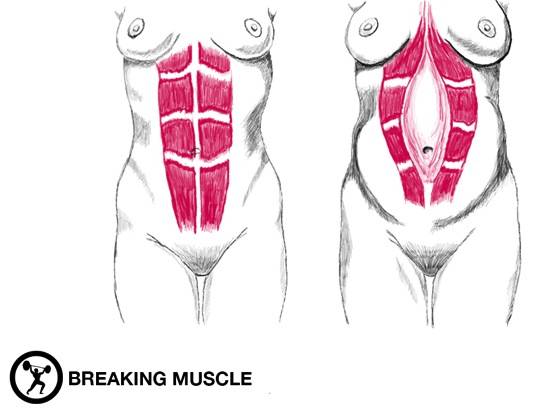
Symphysis Pubis Dysfunction (SPD)
There is one other fun side effect of pregnancy that some women have the joy of experiencing called symphysis pubis dysfunction (SPD). Yes, it is as painful as the name sounds. When you suffer from SPD, the ligaments that are supposed to keep your pelvis aligned become lax. This leads to instability in the pelvic joint, allowing it to move in ways it was never intended to move.
SPD is not only painful, but it also puts a damper on workouts during and after pregnancy. In my experience, any unilateral lower-body movement was off the table. Split squats, lunges, step ups, pistol squats, and lateral jumps would leave me wriggling on the floor in agony and, depending on the severity of pain, sometimes in a pool of urine. I’m just kidding on that one, but it did hurt like hell.
It Doesn’t Stop: Postpartum Pelvic Pain
Why am I telling you all this? After my second pregnancy, I was having a difficult time getting rid of the pelvic pain. Even running hurt. I visited my physical therapist (PT) for what I thought was a separate issue – I couldn’t keep water off my knees. It turned out my hips were all jacked up, which was causing mayhem throughout the rest of my lower body. My PT went straight for pelvic tilts, belly breathing, and abdominal bracing. The resultant stronger muscles picked up the slack of my shirking ligaments, ending my discomfort, improving the integrity of my pelvis, and laying a solid foundation for heavy lifts.
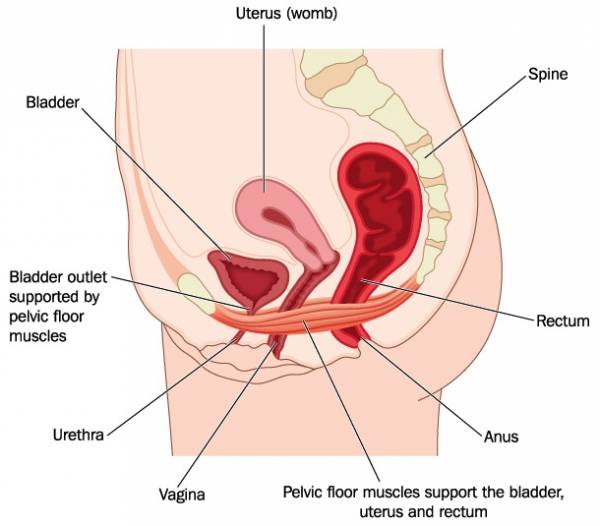
These following exercises target the transverse abdominals as well as the pelvic floor muscles, which are the keystone for a strong core. These exercises are low-key enough that you can begin doing them soon after delivery. If you had a c-section, you’ll want to give yourself more time to heal to prevent opening the incision or further damaging the tissues.
To get on the right track, include pelvic tilts, belly breathing, and abdominal bracing in your daily routine as soon after birth as you comfortably can. Add arm and leg movements to the bracing to prepare your abdomen for more intense movements.
The 6 Core Exercises New Moms Need
Okay, now onto the core of the matter, pun intended. Isometric abdominal exercises will be your bread and butter for the first couple of months after the little darling arrives. These exercises are the most effective way to target the bulk of the abdomen while improving strength throughout your entire midsection.
The American College of Sports Medicine used electromyography (EMG) to determine which abdominal exercises most effectively activated the rectus abdominis and obliques. Researchers found the yoga boat, yoga dolphin plank on a ball, and the yoga side plank to be at the top of the list. Incorporate two to three sets of each of these exercises, holding each one for at least thirty seconds working your way up to one to two minutes, into your workout routine.
1. Belly Breathing
Belly breathing simply involves allowing your stomach to expand and contract as much as possible while you actively inhale and exhale as deeply as possible.
2. Abdominal Bracing
Begin by lying face-up on the floor. Brace your abdomen by contracting your entire abdomen as if you were preparing to get hit in the stomach. This is your starting position. From here, perform different movements such as raising one or both arms overhead or extending your legs while keeping your back flat against the floor.
3. Pelvic Tilt
Lie on your back with your knees bent and feet flat on the floor or propped on a ball. Brace your abdomen and tilt your pelvis back by pressing your lower back into the floor. Hold this position for five seconds then repeat.
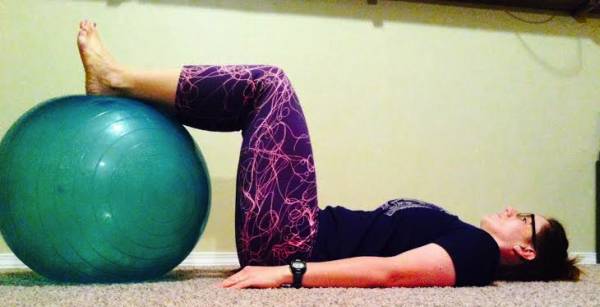
4. Yoga Boat
Sit on the floor with your knees bent. Brace your abdomen, slightly lean your torso back while lifting your feet off the floor. Lift until your shins are parallel with the floor, your back is straight and your hips are flexed to ninety degrees. Extend your arms forward to a comfortable position to help maintain your balance. Hold here for at least thirty seconds.
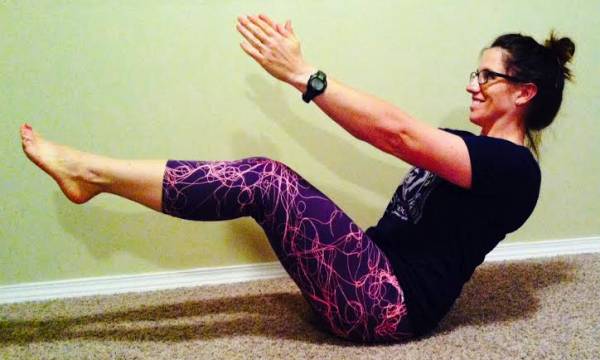
5. Dolphin Plank
Place your elbows on the top of a stability ball and extended your legs out behind. Brace your abdomen and hips, straighten your back and hold the position for at least thirty seconds. This exercise is basically just a standard plank but you’re adding in the instability of the ball.
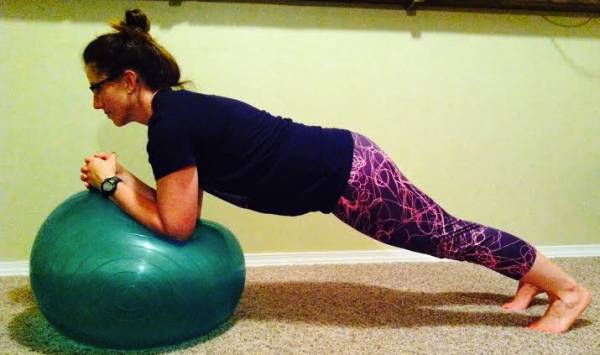
6. Side Plank
Lie on your side with your elbow under your shoulder. Stack your hips and feet, stabilize your core, and lift your hips off the floor until your body forms a straight line. Hold here for at least thirty seconds. Repeat on the other side. Add ten to twenty leg lifts (shown in the video below) to the side plank to further improve hip strength and stability.
Can’t I Just Do Deadlifts?
Is all of this really necessary? Well, technically, you could rely solely on the lifts themselves to get you back into fighting shape, but I guarantee it will be a long haul and you’ll be lifting a lot lighter for a lot longer.
Don’t get me wrong, lifts, especially front squats, are excellent for building core strength. However, when you’re forced to lift light due to the inability to stiffen up your torso and stay erect properly, you’re not going to get a lot accomplished. It’s still a good idea to start light and work your way up, but by adding in additional core work, you’ll start hitting your pregnancy and pre-pregnancy numbers a lot faster.
Note: Please let me clarify, this routine is not going to spot reduce that baby pudge. We all know spot reduction is a crock and the only way to get visible abs again is through diet, regular intense exercise, and time. The basis of this program is to help restore the core strength lost during pregnancy that you can start hitting those heavy lifts sooner after pregnancy and feel like a bad-ass momma again.
References:
1. Olson, Michelle, Ph.D., FACSM, C.S.C.S. “The “Anatomy” of Investigating Abdominal Exercises,” ACSM’S Health and Fitness Journal Vol 17 (2014): 9-14
2. Anthony, Lenita. Pre- and Post-Natal Fitness: A Guide For Fitness Professionals from the American Council on Exercise. California: Healthy Learning, 2002.







